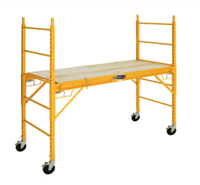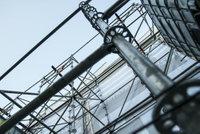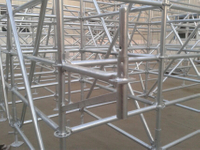Content Menu
● What Is Aluminum Tube and Clamp Scaffolding?
● Material Strength and Engineering of Aluminum Tube and Clamp Scaffolding
● Why Aluminum Tube and Clamp Scaffolding Is Suitable for Industrial Use
>> 1. Versatility and Adaptability
>> 2. Corrosion Resistance
>> 3. Lightweight and Ease of Handling
>> 4. High Load Capacity
>> 5. Compliance with Safety Standards
● Common Industrial Applications of Aluminum Tube and Clamp Scaffolding
● Assembly and Safety Considerations
>> Assembly
>> Safety Features
>> Maintenance
● Advantages Over Other Scaffolding Types in Industrial Use
● Environmental and Economic Benefits
>> Sustainability
>> Cost Efficiency Over Time
● Conclusion
● FAQ
>> 1. Is aluminum tube and clamp scaffolding strong enough for heavy industrial loads?
>> 2. How does aluminum tube and clamp scaffolding compare to steel in industrial environments?
>> 3. Can aluminum tube and clamp scaffolding be customized for complex industrial structures?
>> 4. What safety standards apply to aluminum tube and clamp scaffolding in industrial use?
>> 5. How long does aluminum tube and clamp scaffolding last in industrial settings?
Aluminum tube and clamp scaffolding has become increasingly popular in various sectors, including industrial environments, due to its lightweight, corrosion resistance, and adaptability. This article provides an in-depth analysis of aluminum tube and clamp scaffolding, focusing on its suitability for industrial use. It covers material properties, structural strength, typical applications, safety considerations, maintenance, and cost-effectiveness.
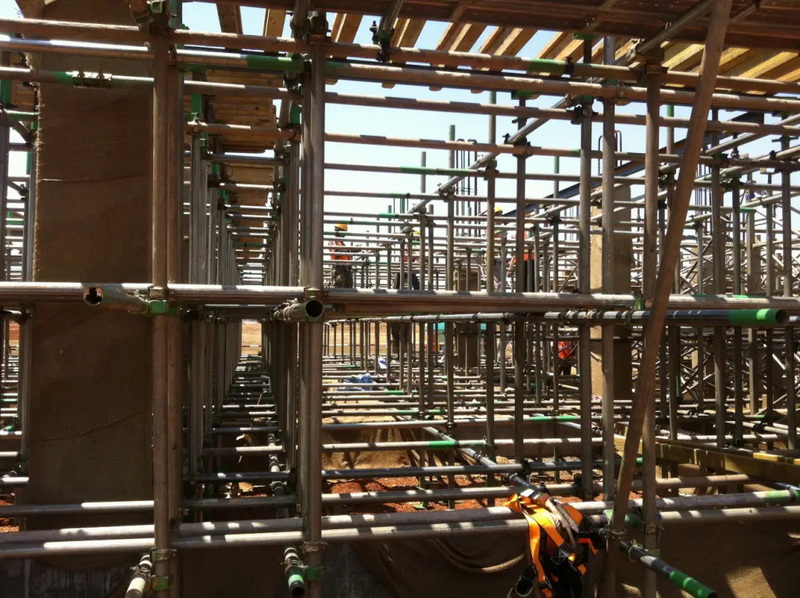
What Is Aluminum Tube and Clamp Scaffolding?
Aluminum tube and clamp scaffolding is a traditional modular scaffolding system composed of hollow aluminum tubes connected by clamps (also known as couplers). The tubes typically have a diameter of approximately 48.3 mm (1.9 inches), and the clamps secure these tubes at various angles, allowing for versatile configurations to suit complex structures and irregular surfaces.
- Tubes: Made from high-strength aluminum alloy (commonly 6082-T6), offering excellent tensile strength and corrosion resistance.
- Clamps: Usually forged steel or aluminum, designed to securely fasten tubes at right angles or other configurations.
- Platforms: Wooden or metal planks placed on horizontal tubes to create working surfaces.
- Accessories: Include guardrails, base plates, braces, toe boards, and safety nets to enhance safety and stability.
Material Strength and Engineering of Aluminum Tube and Clamp Scaffolding
Despite being lightweight, aluminum tube and clamp scaffolding is engineered for durability and strength. The 6082-T6 aluminum alloy used in tubes offers high tensile strength, making it suitable for demanding industrial environments.
- Tensile Strength: Alloy 6082-T6 provides excellent mechanical properties, allowing the scaffolding to support substantial loads.
- Wall Thickness: Tubes typically have wall thicknesses ranging from 2.6 mm to 4 mm, ensuring robustness.
- Breaking Pull-Off Force: Joints can withstand forces of 4100–4400 kg, exceeding typical load requirements for industrial applications.
| Feature | Aluminum Tube and Clamp Scaffolding | Steel Scaffolding |
| Weight | Lightweight (~1.67 kg/m) | Heavier (~2.5 kg/m or more) |
| Corrosion Resistance | Excellent, naturally corrosion-resistant | Prone to rust without coating |
| Durability | Strong, suitable for heavy loads | Very strong, excellent load capacity |
| Ease of Assembly | Easier due to light weight | More labor-intensive |
| Weather Resistance | Withstands rain, UV, temperature changes | Requires maintenance |
| Cost | Higher initial cost, lower maintenance | Lower initial cost, higher maintenance |
| Service Life | 20+ years with proper care | Shorter if not maintained |
Why Aluminum Tube and Clamp Scaffolding Is Suitable for Industrial Use
1. Versatility and Adaptability
Aluminum tube and clamp scaffolding can be configured into almost any shape or size, making it ideal for industrial environments with complex structures such as refineries, power plants, and petrochemical sites. The clamps allow connections at various angles, enabling scaffolds to fit irregular surfaces and tight spaces.
2. Corrosion Resistance
Industrial sites often expose scaffolding to harsh chemicals, moisture, and weather conditions. Aluminum's natural corrosion resistance ensures longevity and reduces maintenance costs compared to steel scaffolding.
3. Lightweight and Ease of Handling
The lightweight nature of aluminum scaffolding facilitates faster assembly and disassembly, reducing labor costs and downtime during industrial maintenance or shutdowns.
4. High Load Capacity
Aluminum tube and clamp scaffolding supports medium to heavy-duty loads, accommodating multiple workers, tools, and materials safely. This makes it suitable for industrial tasks requiring robust platforms.
5. Compliance with Safety Standards
Most aluminum tube and clamp scaffolding systems comply with OSHA, ANSI, and international safety standards, ensuring safe working environments in industrial settings.
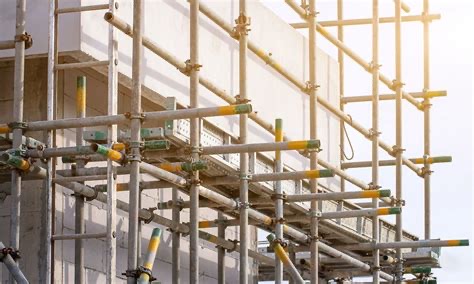
Common Industrial Applications of Aluminum Tube and Clamp Scaffolding
Aluminum tube and clamp scaffolding is widely used across various industrial sectors due to its flexibility and strength:
- Refineries and Petrochemical Plants: For maintenance, inspection, and repair of complex piping and equipment.
- Power Plants: Access to boilers, turbines, and cooling towers during scheduled shutdowns.
- Shipyards: For shipbuilding and repair, where scaffolding must adapt to curved and irregular surfaces.
- Bridges and Infrastructure: Providing stable platforms for inspection and repair work.
- Storage Tanks and Silos: Enabling safe access to large cylindrical structures for cleaning and maintenance.
- Industrial Maintenance: General maintenance tasks in factories and warehouses requiring elevated access.
Assembly and Safety Considerations
Assembly
Aluminum tube and clamp scaffolding requires skilled assembly to ensure safety and structural integrity. The clamps must be securely tightened, and the scaffold must be properly braced and tied to the structure as needed.
Safety Features
- Guardrails and Toe Boards: Prevent falls and falling objects.
- Base Plates and Sole Boards: Provide stable foundations, especially on uneven or soft ground.
- Bracing: Diagonal braces enhance rigidity and prevent swaying.
- Load Limits: Adherence to duty ratings (light, medium, heavy) is crucial to prevent overloading.
Maintenance
Regular inspections for damage, corrosion, and loose clamps are essential. Proper cleaning and lubrication of clamps and moving parts extend the service life.
Advantages Over Other Scaffolding Types in Industrial Use
| Aspect | Aluminum Tube & Clamp Scaffolding | Modular System Scaffolding | Steel Tube & Clamp Scaffolding |
| Flexibility | Highly customizable | Modular but limited shapes | Customizable but heavier |
| Weight | Lightweight | Moderate weight | Heavy |
| Corrosion Resistance | Excellent | Varies | Requires coating |
| Assembly Speed | Moderate | Fast | Slower |
| Cost | Higher initial cost | Moderate | Lower initial cost |
| Durability | Long-lasting | Durable | Durable but prone to rust |
Environmental and Economic Benefits
Sustainability
Aluminum is highly recyclable, and many manufacturers use recycled aluminum in their tubes, reducing environmental impact. The long service life and low maintenance requirements of aluminum scaffolding also contribute to sustainability by minimizing waste and replacement frequency.
Cost Efficiency Over Time
While aluminum tube and clamp scaffolding may have a higher upfront cost compared to steel, its durability, corrosion resistance, and ease of handling often translate into lower total cost of ownership. Reduced labor costs for assembly/disassembly and lower maintenance expenses make it economically advantageous for industrial users.
Conclusion
Aluminum tube and clamp scaffolding is highly suitable for industrial use due to its versatility, strength, corrosion resistance, and compliance with safety standards. Its lightweight nature allows for easier handling and faster assembly, while its adaptability makes it ideal for complex industrial structures. Though it may have a higher initial cost compared to steel, its durability and low maintenance requirements often result in cost savings over time. When properly assembled and maintained, aluminum tube and clamp scaffolding provides a safe, reliable, and efficient solution for a wide range of industrial applications.
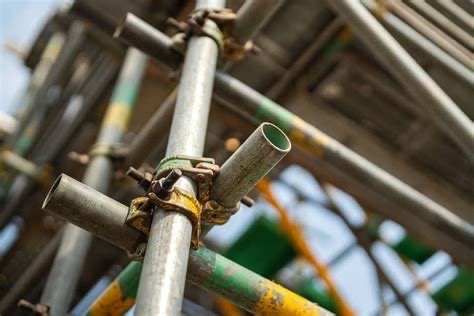
FAQ
1. Is aluminum tube and clamp scaffolding strong enough for heavy industrial loads?
Yes, aluminum tube and clamp scaffolding made from high-strength alloys like 6082-T6 supports medium to heavy-duty loads suitable for most industrial applications.
2. How does aluminum tube and clamp scaffolding compare to steel in industrial environments?
Aluminum is lighter and more corrosion-resistant, making it easier to handle and more durable in harsh environments, though steel may offer higher ultimate load capacity.
3. Can aluminum tube and clamp scaffolding be customized for complex industrial structures?
Absolutely. The clamp system allows connections at any angle, enabling scaffolding to conform to irregular shapes and tight spaces common in industrial sites.
4. What safety standards apply to aluminum tube and clamp scaffolding in industrial use?
Standards such as OSHA, ANSI, and BS EN 1004 govern the design, assembly, and use of scaffolding to ensure worker safety.
5. How long does aluminum tube and clamp scaffolding last in industrial settings?
With proper maintenance and care, aluminum scaffolding can last 20 years or more, outperforming steel in corrosion-prone environments.













